AUCKLAND ART GALLERY, TOI O TĀMAKI, is New Zealand’s largest and most inspiring visual arts experience.
Explore four floors of exhibitions, many centuries of art and one of Auckland's most iconic buildings. Located right in the heart of Auckland city, the gallery is the perfect place to discover some of the best in New Zealand and international art.
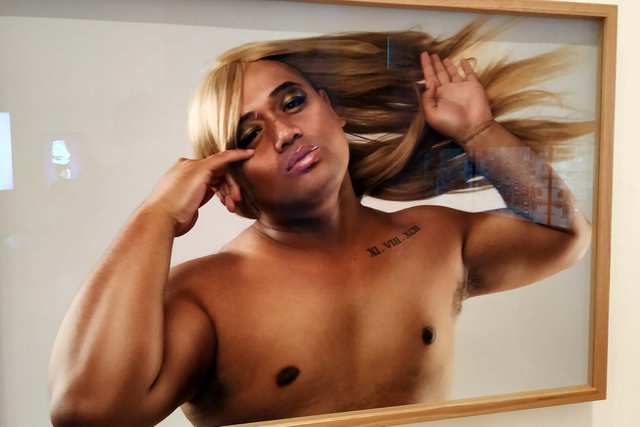
Pati Solomona Tyrell, born 1992, Sāmoa, New Zealand. Masculine Me Tender. 2014-2018 Printed photographs.
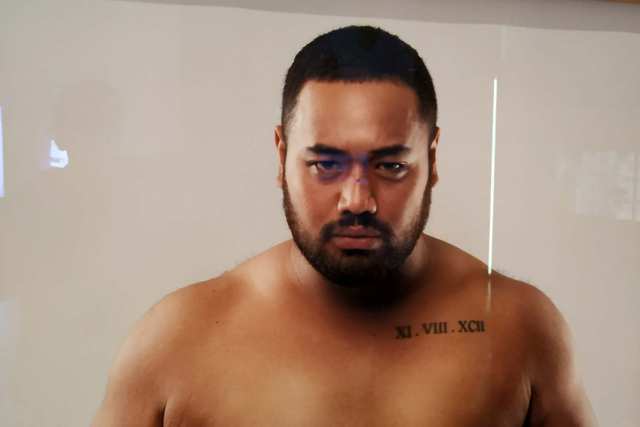
Pati Solomona Tyrell Masculine Me Tender challenges viewer expectations about the reality of gender diversity. Concentrating on ideas about what gender shifts might look like Tyrell shows us that it is possible to inhabit a non-binary gender identity.
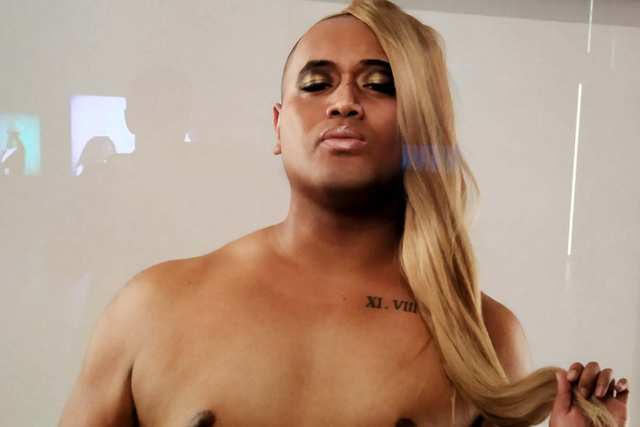
While knowledgeable about the history of Samoan fa'afafine, Tyrell's investigation goes beyond traditional notions surrounding 'the third sex. Describing his work, Tyrell has said:
My art helps me to understand and get through my own journey but there's definitely more to it than that. There's an advocacy about what it means to be young, queer and Pacific. People just assume that Pacific parents don't support their queer children but my parents do. I feel like when people are able to navigate both their femininity and their masculinity without any hang-ups about it, they free themselves.
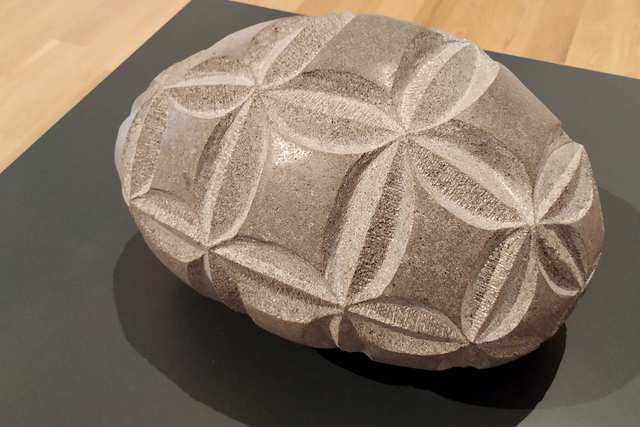
Sopolemalama Filipe Tohi, born 1959, Tonga, New Zealand.
'Veimaka - Waterstone', a work done in 2003, is an eloquent example of Sopolemalama Filipe Tohi use of 'Tufunga Lalava' the Tongan art of spatial and linear intersection.
The carving is connected to the history of Tongan relief lashing, arguably among the most complex weaving processes in the world. Tohi is considered to be a prominent exponent of traditional Tongan lashing.
Art historian Karen Stevenson noted that Tohi is one of a few artists who look to the traditional/cultural aesthetic of the Pacific as a foundation for his contemporary art practice. This is a powerful and expressive sculpture which, although physically small, has a monumental and intense presence.
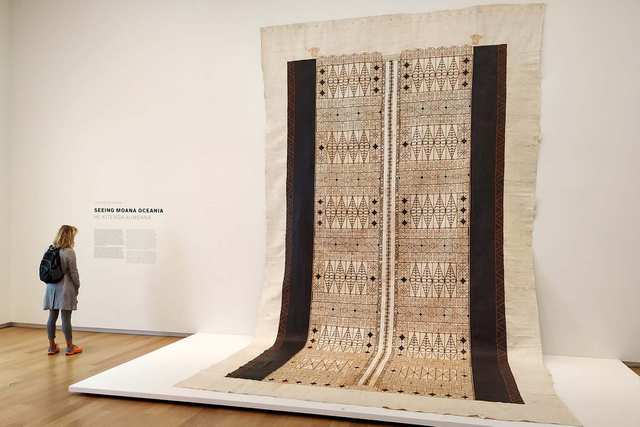
SEEING MOANA OCEANIA
Why do we use 'Moana Oceania' and not 'Pacific'? The name Pacific was given to this region by a Portuguese explorer almost 500 years ago and, with its transliteration Pasifika, is still used.
In Aotearoa New Zealand and other island nations, such as the Cook Islands, Hawai'i Samoa and Tonga, 'Moana' means ocean or vast space. For this reason it has relevance for Aotearoa New Zealand, an island nation with ancestral links to the wider Moana.
Oceania is also a foreign name, first popularised in the early 19th century, and is today a common alternative for Pacific because it suggests a sea of islands connected to each other.
The phrase 'Moana Oceania', then, empowers and privileges Indigenous perspectives, which are strongly connected to Aotearoa and share roots with the wider 'Moana Oceania'.
Paul Tangata, of Cook Islands heritage, and Teuane Tibbo, of Samoan heritage, were the first Moana Oceania artists to exhibit frequently in Auckland.
In the generations since their pioneering work, this city has become home to many more artists and their creativity, one of our region's emblems, has helped shape the identity of this place.
Seeing Moana Oceania presents key works by artists who affirm their diverse 'Moana Oceania' cultures within contemporary art practice. These artists look forward in time to a culturally rich, diverse Aotearoa New Zealand.
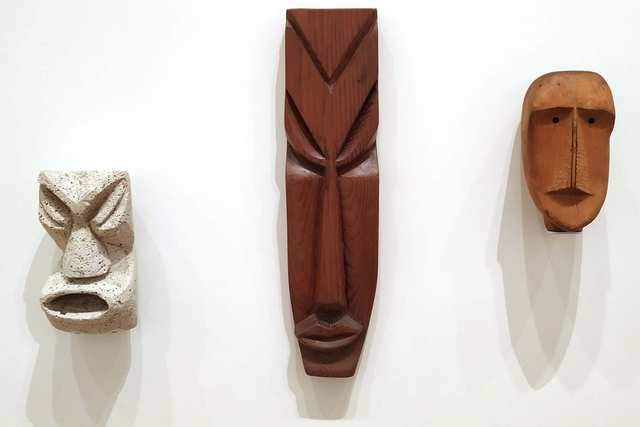
Left to right: Arnold Manaaki Wilson (1928-2012) Head (1958) + Arnold Manaaki Wilson Mask (1955) + Selwyn Muru (born 1937) Untitled (1975).
The 1950s witnessed the rise of the first generation of Fine Arts trained Māori artists. This young group represented a radical turning point in Māori art as they consciously broke away from the traditional carving practices of their forebears to create new carved and painted expressions about their Māori heritage.
They fused a unique understanding of Māori knowledge and cultural narrative with that of Western Fine Arts learning and practice.
Māori creation narratives and the relationship of people to the whenua (land) are told through the ideas, mediums and techniques of the times in which they lived.
The artists whose work you see in this room were greatly influenced by the modernist art movement, and particularly by sculptors Barbara Hepworth, Henry Moore and Constantin Brâncuşi.
This influence is evident in the pared-back simplicity of the human form and in the piercing of forms where the void' produces the weight of both positive and negative space. The works are bold, confident and explorative.
Today, we appreciate these artists' forthright artworks as the radical beginnings of contemporary Māori art.
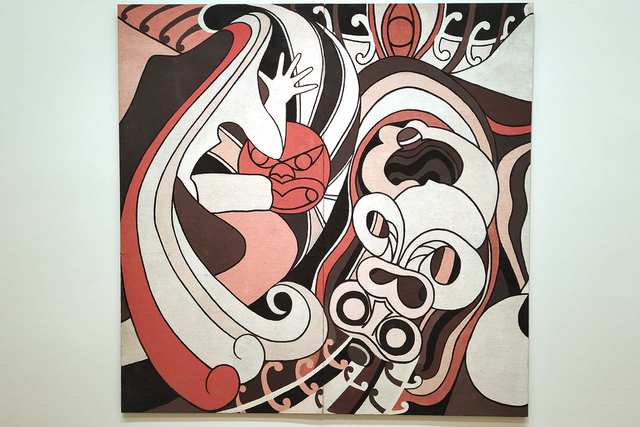
Arnold Manaaki Wilson (1928-2012) Ngai Tuhoe, Ngāti Tarawhai, New Zealand.
Te Tu a te wahine, acrylic on hessian on chipboard, done in 1974, relates to the transformation of females from girlhood to young adulthood and was commissioned by Queen Victoria Māori Girls School in 1974 to be installed in the accommodation dormitory.
As with the sculptural works by Arnold Manaaki Wilson, his painting practice connects with the importance of customary narratives in articulating a position in the present.
With the 'hei tiki' (pendant) form at its centre, this very expressive painting honours women of 'mana' (fortitude) both past and present.
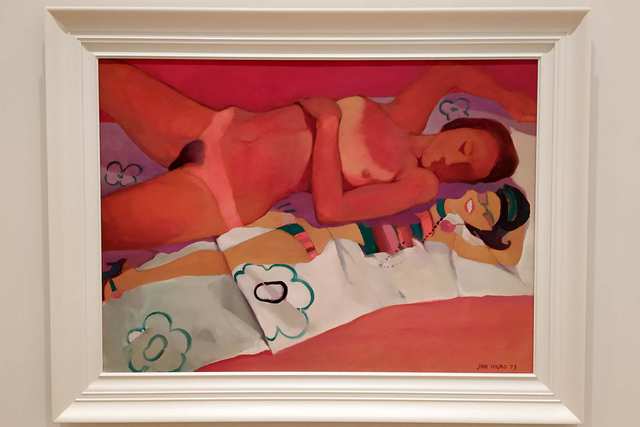
Jan Nigro (1920-2012), New Zealand, Sunbather 1973, oil on canvas.
For many years this painting was considered confrontational and was rarely exhibited. Jan Nigro began her studies at the Elam School of Fine Arts in Auckland in 1937, where she worked under AJC Fisher, a strong proponent of figurative painting.
For seven decades, Nigro used the nude to explore social mores within a range of different media and styles. In Sunbather, the depiction of tan lines and pubic hair creates a sense of enhanced reality which disrupts traditions of the ideal classical nude.
The presence of the groovy, scantily clad figure on the beach towel, with swinging necklace and dangling earrings, contrasts the serenity of the sunbather, while also heightening her nakedness.
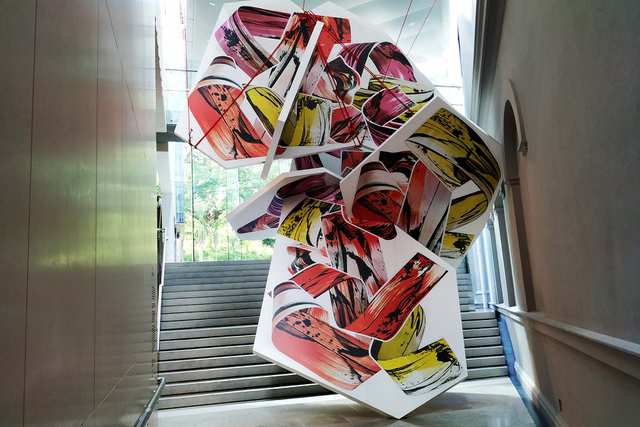
Judy Millar, Rock drop, wood, digital print on vinyl synthetic rope, 2017.
Playing with the complexity of this light-filled junction between the building's Victorian, neo-classical and 21st century architecture, Millar's gargantuan painterly installation responds to the dynamics of the space.
Viewed from the atrium's many vantage points, Rock Drop, 2017 appears to morph in shape and scale. Thinking through how the artwork might be experienced, Millar returned to the stairway as the most crucial element in her project:
Stairways suggest temporal shifts and have been used throughout the history of painting to add action to pictorial space. This artwork will work with the progression of the stairway, using it in a dynamic way. I'm thinking of the work as an interlude, even a comic interlude, in the experience of a gallery visit. I'm playing with the complexity of the South Atrium space, building an object that looks different from every angle. As you move around it, it will change, suggest new things, loom over you, block your view, and seem to move away from you. For anyone who has read The Odyssey, the work will be like the Wandering Rocks taunting your passage with trickery and the use of illusion.
Judy Millar (born 1957) lives in Auckland and Berlin. She works from a conceptual painting framework that freely references painting's recent histories, particularly delighting in plundering the expressiveness of gestural painting.
An increasing dialogue in Millar's work between architecture and painting, between three dimensional space and the painted surface, questions the traditional relationship between the art object and the exhibition space.
A hallmark of her practice is a process of erasure, wiping or scraping paint off the surface of the work. The resulting image of positive and negative space of tension and calm, compression and expansion is an elaboration of the pictorial space.
Millar's recent scaling up and translating of the painted surface through digital photography, as seen in Rock Drop and in her New Zealand pavilion work at the Biennale Arte 2009 in Venice, has arresting new sculptural possibilities.
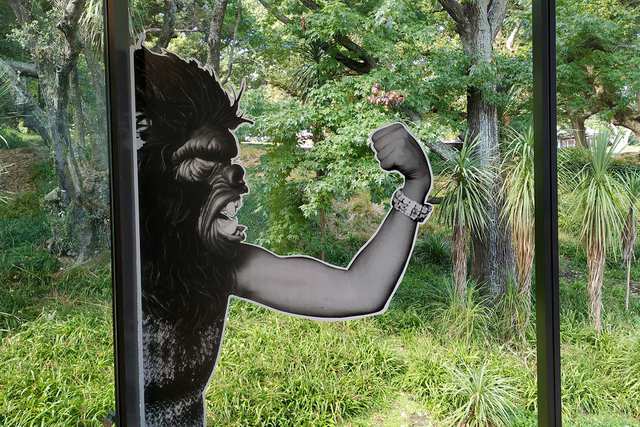
TWO STEPS FORWARD, ONE STEP BACK.
The Guerrilla Girls are still waiting for the day when everyone will think of the Feminist as a positive stereotype. Don't let us wait too long. - Guerrilla Girls
Like the issues they critique, the Guerrilla Girls' practice is ongoing cyclical and reiterative. Returning to their statistics from the 1980s between 2012 and 2014, the collective have found little if any, progress in institutions they have examined over the past 30 years.
Inequality and discrimination still afflict art galleries, politics, the music industry, the film industry, as well as daily life. Rather than being disheartened, the Guerrilla Girls remain determined and optimistic.
There has been some progress. Instead of convincing people and institutions that the situation is wrong, the Guerrilla Girls say that they are now, for the most part reminding people who want to change the system that they need to break out of old habits.
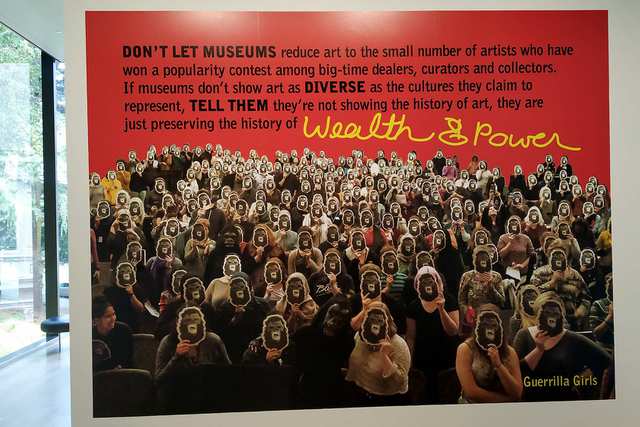
The Guerrilla Girls continue to question, reveal and challenge buoyed by the knowledge that their work has empowered artists and students to question the power mechanisms governing society.
Through working with and being the target of the Guerrilla Girls, art institutions have begun to re-examine and remedy their collections.
The Guerrilla Girls are one of many collectives fighting for equality and transparency. They encourage everyone to pick their own crazy, creative way to be a feminist and 'go bananas'
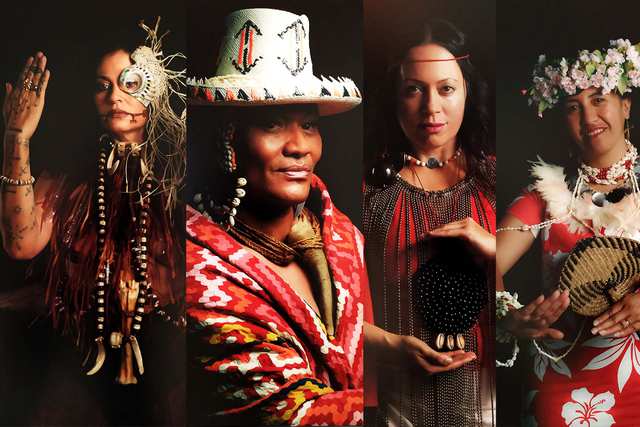
We were trying to find a voice within a society that did not want to recognise us, or didn't know how to recognise us. Rosanna Raymond, 2014
The Pacific Sisters is a collective of Pacific and Māori fashion designers, artists, performers, and musicians that electrified 1990s Auckland.
The group began on the fringes, but their ground-breaking style and performances brought the urban lives of a New Zealand-born, Pacific generation into the mainstream spotlight.
PACIFIC SISTERS 1991, NZ Selina Haami 1965, Sāmoa/NZ Jaunnie 'Ilolahia, Tonga/NZ Ani O'Neill 1971, New Zealand/Cook Islands Rosanna Raymond 1967, Samoa/NZ Lisa Reihana 1964, Ngapuhi iwi, NZ Suzanne Tamaki, Tühoe and Ngati Maniapoto iwi, NZ Henzart @ Henry Ah-Foo Taripo 1965, NZ/Cook Islands Nephi/Niwhai Tupaea, Ngati Katoa iwi, NZ Feeonaa Wall 1972, Sämoa/Sweden/Germany/NZ
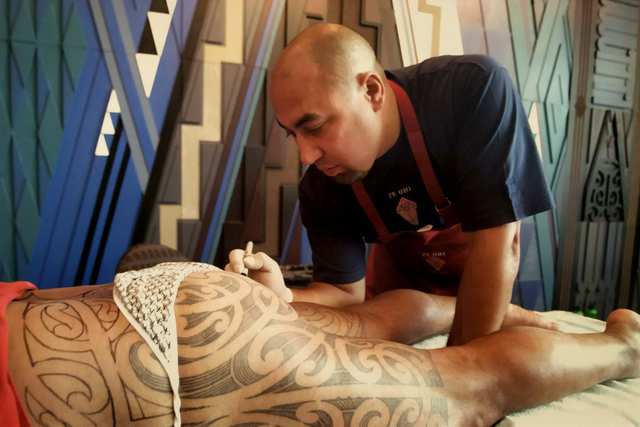
LIVING PORTRAITS, RANGI KIPA
These photographs document 'tohunga ta moko' (master tattooist) Rangi Kipa completing the 'puhoro' (thigh tattoo) on recipient 'Turama Hawira'.
Here we see the ongoing practice of 'ta moko' (Māori tattoo) knowledge and its place in Māori culture today. 'Tā moko' can be understood as a visual narrative that tells of the recipient's lineage and status, personal accomplishments and social standing.
Various sections of the body, from the chin to the lower cheeks, from the forehead to the nose and the thighs, carried a particular statement about that person.
Today, 'ta moko' practitioners like Kipa are reviving and extending upon this visual language by offering new variations to customary patterns which are personally relevant to the recipient and the contemporary life and times within which they live.
In this image we see the living connection to cultural practices and traditions that continue to have meaning and resonance for Māori society in the 21st century.
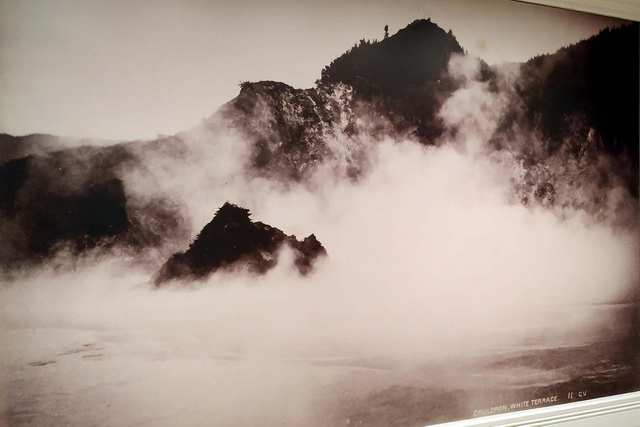
BURTON BROTHERS AND THE CREATION OF A PHOTOGRAPHIC WONDERLAND
Walter John Burton and Alfred Henry Burton were among the most renowned of New Zealand's colonial commercial photographers. After moving to Dunedin from England in 1866 Walter established a photographic studio, the booming success of which persuaded Alfred to follow in 1868.
While Walter focused primarily on producing photographic portraits, Alfred travelled extensively throughout New Zealand, taking photographic views of the landscape, the industrial developments in the colony, and the people he encountered.
The studio's acquisition of a portable dark-van in 1869, enabled the development of wet-plate negatives in the field, made this possible.
The Wonderland album is one of several albums that the studio produced to package the New Zealand landscape for aspiring, or curious 'armchair' travellers.
Comprising over 189 views from across the country, the Wonderland album leads the viewer on a cyclical journey that starts at the thermal regions of Rotorua, then proceeds with journeys down to the forests, lakes, mountains and various settlements of the North and South Islands, and then concludes with images of the devastating impact of the 1886 eruption of Mount Tarawera in the Rotorua region.
In so doing, the Wonderland album extols New Zealand as a land of sublime natural beauty, heralds the progress of colonial re-shapings of the landscape, and piques viewer fascination with the terrible convulsions of Nature in the Antipodes.
This is a reproduced selection of photographs from the album, which have been arranged to recreate the chronology of the album as faithfully as possible.
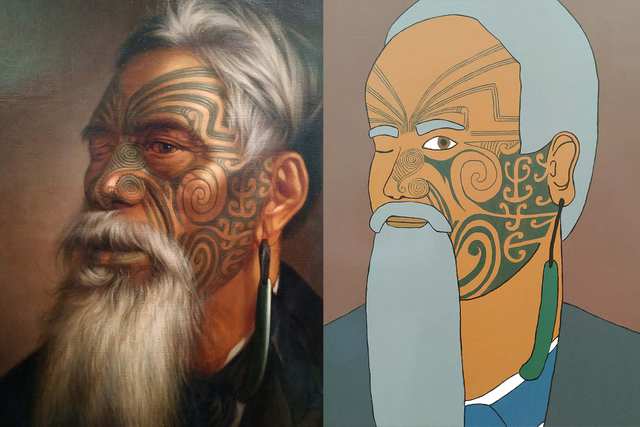
Gottfried Lindauer (1839-1926), New Zealand, Bohemia, Renata Kawepo, Tama ki Hikurangi 1885.
Renata Kawepo (?-1888) was a Ngati Kahungunu leader. His given names were Kawepo Tama-ki-Hikurangi and he had 'mana whakapapa' (senior descent lines) over extensive estates in the Heretaunga region of Hawke's Bay, His adult life was spent in service to his 'iwi' (tribe).
He was a teacher and missionary to Māori, involved in traditional dispute resolution practices, and he played a role in tribal and intertribal warfare against Ngapuhi.
Kawepo received his rangi paruhi (full-face tattoo) after a 10-year period as a prisoner of Ngapuhi. While in captivity he was taken to the Church Missionary Society at Waimat in the Bay of Islands and he became a Christian, taking the baptismal name Renata (Leonard), Renata Kawepo gave land and money to establish schools for Māori students Heretaunga.